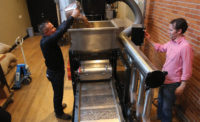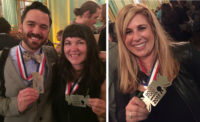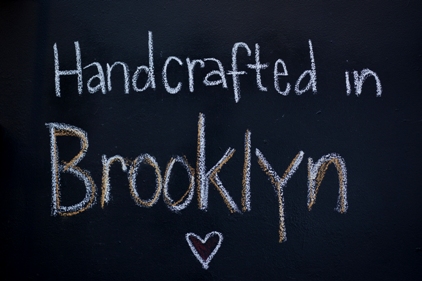
|
“Impalpable sustenance,” from the tradition of Brooklyn foodways, usually meant pizza, bagels and Coney Island hot dogs. That’s pretty homely cooking.
So why are people – even Manhattanites – now crossing over to Brooklyn in search of culinary excellence? For Left Coasters and the American Heartland, Brooklyn ceased to have cultural relevance by 1957 when the Dodgers left town.
The Brooklyn food scene is booming, so much so that the borough has spawned its own off-shoot of the New American Cuisine made popular by Alice Waters.
Our Brooklyn survey includes six hipster Brooklyn chocolate makers with regional to international reputations. They range in experience from the one-step-removed from the apartment kitchen level production, to having established Food Network star power.
As an indicator of chocolate trends, two companies make raw chocolate, four ethical chocolate (i.e., fair trade and/or organic) and five bean-to-bar chocolate. In terms of professional backgrounds, three chocolate makers were/are musicians and three are former chefs.
So what’s with the hipster fixation with bean-to-bar? Is it a passing fad, or new tradition?
On the one hand, proponents will tell you that bean-to-bar gives the chocolate maker greater control over the entire creative process. But, on the other hand, managing the entire process exposes the chocolate maker to more challenges and risks. “A great bean-to-bar chocolate can give you a wonderful experience once. The challenge is to give it to the consumer five times,” cautions Valrhona’s Case. With so many variables, producing a consistently good bar is a lofty goal to achieve.
1. Jacques Torres Chocolate
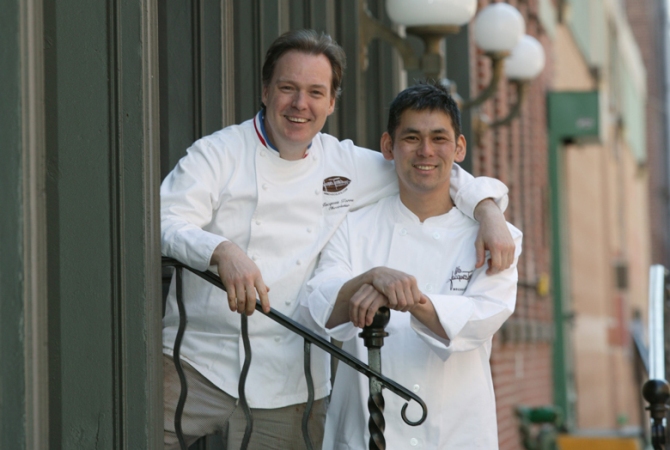
|
We will start our tour at Jacques Torres Chocolate. Jacques Torres became the pioneer Brooklyn artisan chocolate maker when he opened a factory/store in 2000. He was attracted to the area by the affordable rent — an important factor for a startup — and accessibility from Manhattan via two non-toll bridges (the district is called DUMBO for “down under the Manhattan Bridge overpass”). The historic mercantile neighborhood is lined with cobblestone streets, 19th century warehouses that once reportedly stored coffee and spices and affords a magnificent waterfront view of Manhattan.
Jacques specializes in beautifully crafted pieces of chocolate, such as necktie-shaped bars for Father’s Day, a creative nod to his days as executive pastry chef at the legendary Manhattan restaurant Le Cirque. And in contrast to the other Brooklyn chocolate makers who make mostly bars, he carries a full line of confectionery products including hot chocolate mixes, baking products, cookies and truffles. Several of his creations are rifts on the household familiar, like the milk chocolate-covered Cheerios. Some of his bars are bean-to-bar, Jacques being the first bean-to-bar maker in the area.
Catching the artisan chocolate making wave at the right time, Jacques’ business has flourished. In May, he announced that his chocolate making operations will shift to a 40,000-sq.-ft.- factory being repurposed at the World War I-era Brooklyn Army Terminal. Factory tours will be offered.
Jacques’ chocolate-making philosophy centers “on real and simple ingredients,” using real cream and butter, true flavorings and real raspberries. Most importantly, he doesn’t take any short cuts.
2. Mast Brothers Chocolate
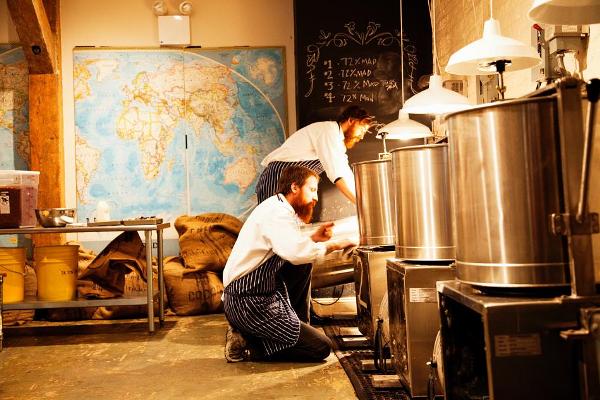
|
When Rick Mast’s interest in classical music waned, (he was a professionally trained opera singer), he moved onto food, his next favorite passion. “I have a very curious brain and am always trying to figure out how food gets made,” he said. Mast and his brother Michael started making beer, wine and cheese in their small Brooklyn apartment. That lead him to explore how chocolate is made.
What Rick soon discovered was that most chocolate is made using industrial-sized processes. While this produces affordable and widely available chocolate, it also disconnects people from how it is made.
“In the culinary world, in contrast, everyone wanted to develop a personal connection with their food, like where did that heirloom tomato come from, or how was that cow raised?” he explains. “But chocolate seemed to bypass that criterion.”
Soon, Rick and Michael were stashing sacks of beans in their living room and grinding them in their kitchen. In 2007, after three years of experimenting, they quit their day jobs and opened Mast Brothers Chocolate.
Along the way, they discovered that their neighbors were conducting similar explorations with food making. And some of them have gone on to open their own workshops and factories, like the Mast brothers. “It was kind of a bubbling thing that people were trying to figure out in Brooklyn.”
The closeness of this Brooklyn food community naturally encouraged collaboration, like producing the 3Beans beer mentioned above, or pairing chocolate with locally distilled whiskey. “We believe that if you pair two things you love, you’ll be in for a good night. If you are George Costanza and love sex and sandwiches, you should pair those two things,” counsels Rick.
Mast Brothers has a robust international following, but particularly in Japan, France and Singapore, “countries with a traditional respect for human-scale crafted makers of food.” On any Saturday, lines of Japanese and French tourists queue up in front of the retail store and on Valentine’s Day several years ago, the brothers appeared on the Japanese version of Good Morning America, with a viewership of 20 million. Alain Ducasse included the MastBrthers in his new book J’Aime New York (I Love New York) and has opened a bean-to-bar chocolate shop in France modeled on their operation.
Mast Brothers also has a Michelin star pastry chef on staff to support its growing list of A-rated Manhattan restaurant clients and Rick has given talks at the Culinary Institute of America.
In October, the brothers will release their first cookbook. Titled Mast Brothers Chocolate: A Family Cookbook, it will include around 100 recipes, with accompanying short stories. The foreword was written by the French Laundry’s Thomas Keller.
3. Nunu Chocolates
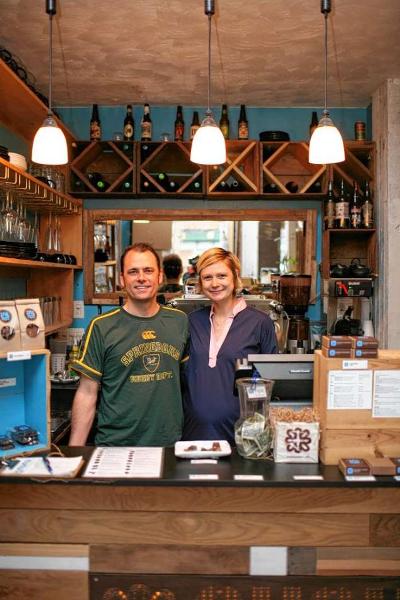
|
Nunu is another example of a chocolate company founded by a musician, Andy Laird, and his wife Justine Pringle. While on tour, they hit upon the idea of selling custom made chocolate to differentiate themselves from the typical concert tour merchandise offerings of t-shirts, CDs and posters. Justine selected the name “Nunu,” which is an affectionate term for “little kid” in South Africa, where she spent her youth. Nunu’s cacao is organic and sustainably farmed from a family-run farm in eastern Colombia. Receiving a good response, they soon were selling to the local shops in their Boerum Hill community and then beyond. Their chocolates can be found in dozens of locations in the four New York City boroughs and even in a pop-up shop in the Marais District of Paris.
Two of Nunu’s more unusual offerings are the Booze Box, containing bonbons infused with a collection of alcohol, including absinthe, moonshine, sake, rye, mescal-chili and amarula and the Beer Box, bonbons infused with the same beer served at the café. At the time of our visit, the beers included three IPAs, a Barrier Medulla English, Ithaca Flower Power and Greenport Harbor Black.
4. Cacao Prieto
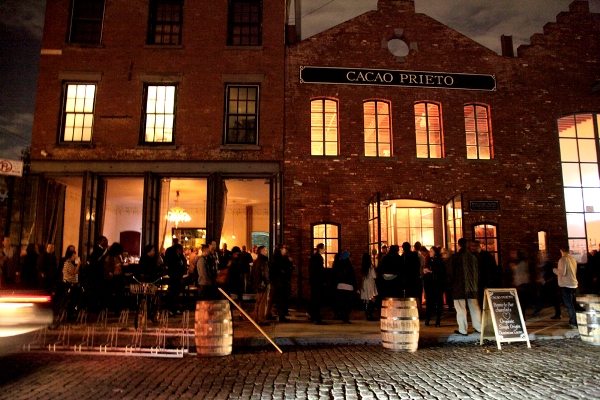
|
Cacao Prieto founder Daniel Prieto Preston is using his scientific background (he holds 100 patents) and his family’s Dominican cacao plantings to establish one of the world’s few vertically integrated premium chocolate production operations. His family is in the process of expanding their hundred year old cacao plantation by clearing 2,000 hectares of low-bearing coconut palms and planting two million cacao seedlings of carefully selected and propagated rare cacao varieties.
“I never thought I would fancy myself a farmer, but I also never dreamed just how much science is involved in operating a self-sustaining farm (and how difficult it could be),” he said in an interview last year posted at GastroGnomes.
Slated to employ 1,600 workers, this operation will require the building of an entire new town, complete with schools, saw mill, brickyard and churches. Preston seems like a latter-day Milton Hershey.
Cacao Prieto makes a variety of bars (all 72%), bonbons, fruit preserves, nut & cacao spreads, jams and caramels.
The company also operates a distillery on premise to produce liqueurs and rums from its cacao. At the San Francisco World Spirits competition, its Don Daniel Rum Liqueur won a bronze in 2013 and its Don Rafael Cacao Rum a double gold in 2012.
5. Raaka Chocolate
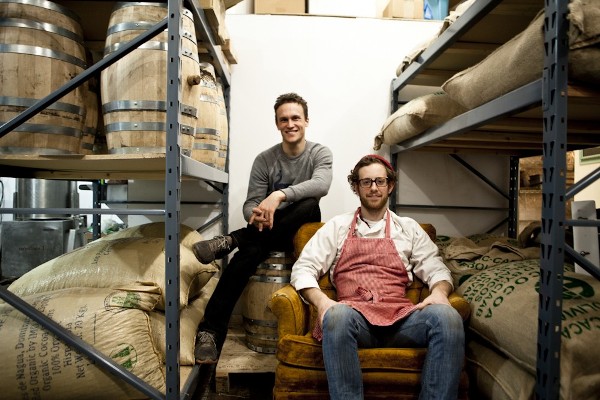
|
Raaka means “raw” in Finnish, a name picked for its sound rather than for any personal connection. The company is one of the only a small handful of chocolate makers making raw bean-to-bar products. Raaka Chocolate was founded by Ryan Cheney, an artist and computer programmer, and Nate Hodge, a gastronomist and musician. The company started making bars in 2010 and selling them at local Brooklyn farmers markets.
In the making of raw chocolate, which obviously forgoes roasting, the highest temperature that the beans are subjected to comes during the grinding phase, about 135°F, or less than half that of roasting. Raaka uses the term “virgin,” borrowed from the cold-press process of olive oil. For Cheney, the advantage of raw chocolate is that less processing maintains chocolate’s natural taste and heart-healthy phenolic content. All Raaka bars are vegan, organic, allergen-free and fair trade.
The end result is some pretty tasty chocolate bars. Raaka’s Bourbon Cask Aged 83% bar received a 2013 Good Food Award. The nibs are aged for 30 days in bourbon casks, thus picking up caramel and earthy flavors.
In a true spirit of Brooklyn artisan community collaboration, Raaka supplies nibs and chocolate as ingredients to local ice cream makers, vegan bakeries, brewers and gin makers. And, in turn, hires local carpenters to construct its displays from reclaimed wood pulled from old Brooklyn buildings. Local web developers to keep the web site updated. “There’s a whole spirit of trading services, mutual support and innovation among we artisans that helps keep our costs [in check],” says Cheney.
Raaka is also a social venture. Its mission is to create a culture of respect, creativity, fun and joyfulness at work and to support fair trade practices in the supply chain. The company is currently working with Haitian cocoa farmers who will eventually export the first Haitian fair trade cocoa in many years. Raaka also espouses such green manufacturing practices as using 100% post-consumer recycled paper and soy-based inks and donating its cocoa shells as mulch to the Edible Schoolyard NYC, an after-school gardening program established by Alice Waters
6. Fine & Raw Chocolate Factory
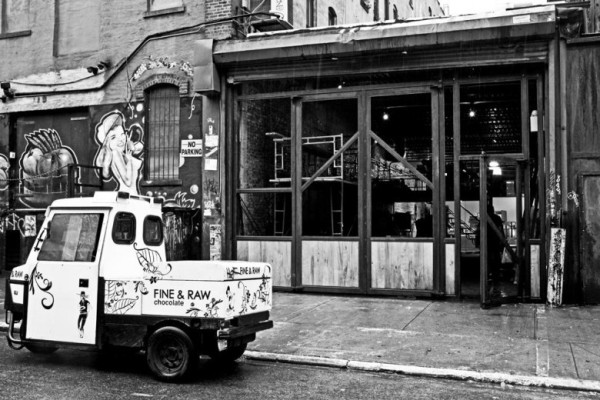
|
Daniel Sklaar’s creative pilgrim’s progress has evolved from New York financial analyst to raw food chef in the high desert of Arizona and now chocolate maker in the Bushwick area of Brooklyn.
Bushwick has recently developed a reputation for being the Wild West of Brooklyn because its relatively low rents are attracting artists priced out of gentrifying Williamburg. “It’s a supportive environment, explorative, that allows for crazy things, such as this raw chocolate factory,” says Fine & Raw’s Operations Assistant Ryann Mead.
Marching to the mission of “saving the world through silliness and chocolate,” Fine & Raw makes bars, chunky bars and truffles, with organic ingredients. Sklaar believes that raw chocolate preserves the “flavor, nutrients and vitality of this celebrated food and keeps it alive and buzzing.” For sweeteners, it uses blue agave and sometimes lucuma. Fine & Raw is in the process of becoming a bean-to-bar operation.
The chocolate factory also serves as a performance space, hosting artists, musicians and dancers. The most recent exhibit featured a neon light installation artist who created something akin to a sci-fi-tron.
Fine & Raw sells its chocolate at the factory, several locations around New York that are serviced by an adorable scooter delivery truck nicknamed “Kushy”, online and at various (Sklaar characterizes them as “random”) international spots, such as a surfer shop in Tokyo.
And that’s the exciting thing about the Brooklyn artisan chocolate scene. It supports a wide variety of styles and attitudes, from the high chic of Jacques Torres to the edginess of Fine & Raw. There is something for everyone’s chocolate palate.
Curtis Vreeland, president of Vreeland & Associates, specializes in confectionery market research. He has been spotting trends in the premium confectionery for Candy Industry Magazine for six years. He can be reached at cvreeland@vreelandassociates.com. Leah Bhabha posts about her food experiences at www.onehungrypickle.com and for the Huffington Post.



